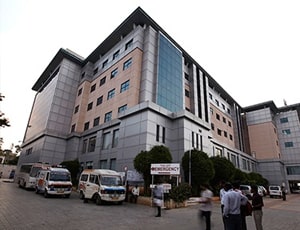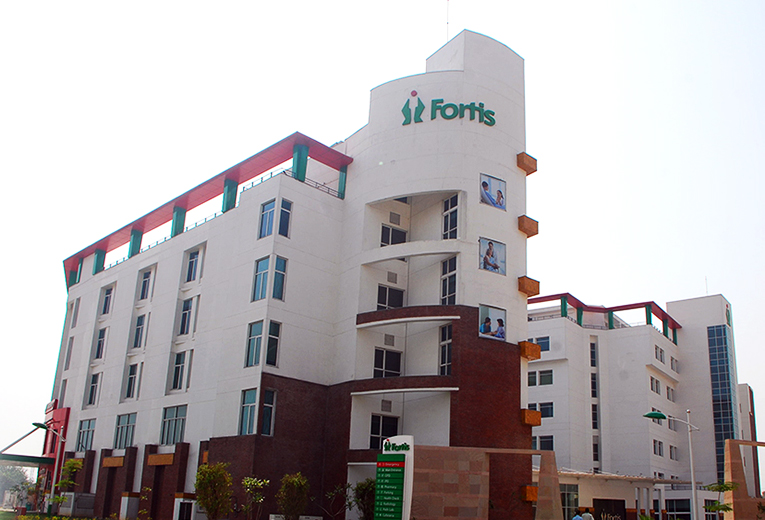Microwave Endometrial Ablation cost in India varies between INR 503057 to 587039 (USD 6050 to USD 7060)approx
.Microwave endometrial ablation is a gynecological procedure in which the innermost part of the uterus is destroyed by people who suffer from excessive vaginal bleeding. If any fibroids, polyps or cancerous cells are there, these are removed or taken care of by the surgeon to avoid any complications that may be caused by them. Dysfunctional uterine bleeding is the major cause of excessive menstrual bleeding in women. The surgeon provides therapy to shrink the endometrium, then it is ablated and microwave radiation is directed which is removed through the cervix.
India provides really cost-efficient treatment for endometrial ablation. There are several other methods by which endometrium can be treated viz electrosurgery, cryoablation, free-flowing hot fluid radiofrequency. Although endometrial ablation is not preferable for all those women who show significant symptoms like cramping during menstruation or who have cancer in the uterus. Although endometrial ablation is more preferred than a vaginal hysterectomy for better results.
The cost of treatment of endometrial surgery varies differently in different. The average cost of Endometrial Ablation starts from USD 4000 in India while on the other hand, it starts from USD 8500 in the US.
Endometrial resection or ablation costs near about USD 6185, while on the contrary hysterectomy price ranges from USD 6785. Such processes decrease the complications that might be caused if the problem is left untreated. Hence it is better to find a good doctor and get treated so that further complications and unnecessary hassle can be avoided
| City | Minimum Cost | Maximum Cost |
|---|---|---|
| Faridabad | USD 6260 | USD 6660 |
| Kolkata | USD 6060 | USD 6940 |
| Bengaluru | USD 6030 | USD 6810 |
| Mohali | USD 6570 | USD 6950 |
| Gurgaon | USD 6060 | USD 6820 |
| Kochi | USD 6080 | USD 6900 |
| Noida | USD 6020 | USD 7040 |
| Hyderabad | USD 6020 | USD 6580 |
| Mumbai | USD 6160 | USD 7070 |
| Panjim | USD 6180 | USD 6880 |
Treatment cost

Types of Microwave Endometrial Ablation in Apollo Hospitals Bannerghatta and its associated cost
| Treatment Option | Approximate Cost Range (USD) | Approximate Cost Range (INR) |
|---|---|---|
| Microwave Endometrial Ablation (Overall) | 4480 - 7247 | 361093 - 607050 |
| Type 1 Microwave Endometrial Ablation | 3991 - 6874 | 322830 - 548047 |
| Type 2 Microwave Endometrial Ablation | 5095 - 7902 | 415199 - 642059 |
DOCTORS IN 13 SPECIALITIES
FACILITIES & AMENITIES

Types of Microwave Endometrial Ablation in Fortis Hospital and its associated cost
| Treatment Option | Approximate Cost Range (USD) | Approximate Cost Range (INR) |
|---|---|---|
| Microwave Endometrial Ablation (Overall) | 4070 - 6569 | 333003 - 542607 |
| Type 1 Microwave Endometrial Ablation | 3565 - 6109 | 292619 - 500670 |
| Type 2 Microwave Endometrial Ablation | 4557 - 7137 | 374663 - 582065 |
DOCTORS IN 12 SPECIALITIES
FACILITIES & AMENITIES

Types of Microwave Endometrial Ablation in Fortis Hospital and its associated cost
| Treatment Option | Approximate Cost Range (USD) | Approximate Cost Range (INR) |
|---|---|---|
| Microwave Endometrial Ablation (Overall) | 4080 - 6596 | 331791 - 539258 |
| Type 1 Microwave Endometrial Ablation | 3543 - 6082 | 292107 - 500105 |
| Type 2 Microwave Endometrial Ablation | 4556 - 7127 | 374364 - 582596 |
DOCTORS IN 12 SPECIALITIES
FACILITIES & AMENITIES


Types of Microwave Endometrial Ablation in Ruby Hall Clinic and its associated cost
| Treatment Option | Approximate Cost Range (USD) | Approximate Cost Range (INR) |
|---|---|---|
| Microwave Endometrial Ablation (Overall) | 3796 - 6044 | 303223 - 503240 |
| Type 1 Microwave Endometrial Ablation | 3271 - 5548 | 268034 - 453182 |
| Type 2 Microwave Endometrial Ablation | 4220 - 6478 | 346001 - 536440 |
DOCTORS IN 13 SPECIALITIES
FACILITIES & AMENITIES

Types of Microwave Endometrial Ablation in Yashoda Hospital, Malakpet and its associated cost
| Treatment Option | Approximate Cost Range (USD) | Approximate Cost Range (INR) |
|---|---|---|
| Microwave Endometrial Ablation (Overall) | 4073 - 6578 | 332880 - 543305 |
| Type 1 Microwave Endometrial Ablation | 3562 - 6087 | 291248 - 498489 |
| Type 2 Microwave Endometrial Ablation | 4546 - 7132 | 373667 - 583751 |
DOCTORS IN 10 SPECIALITIES
FACILITIES & AMENITIES

The cost for Microwave Endometrial Ablation ranges from USD 6380 - 6740 in Max Super Specialty Hospital, Vaishali
Max Super Specialty Hospital, Vaishali located in Ghaziabad, India is accredited by NABH, NABL. Also listed below are some of the most prominent infrastructural details:
DOCTORS IN 14 SPECIALITIES
FACILITIES & AMENITIES

Types of Microwave Endometrial Ablation in BGS Gleneagles Global Hospitals and its associated cost
| Treatment Option | Approximate Cost Range (USD) | Approximate Cost Range (INR) |
|---|---|---|
| Microwave Endometrial Ablation (Overall) | 4518 - 7438 | 376842 - 601077 |
| Type 1 Microwave Endometrial Ablation | 3894 - 6678 | 319215 - 541870 |
| Type 2 Microwave Endometrial Ablation | 5037 - 7930 | 406573 - 645474 |
DOCTORS IN 14 SPECIALITIES
FACILITIES & AMENITIES

Types of Microwave Endometrial Ablation in Wockhardt Hospital, Umrao and its associated cost
| Treatment Option | Approximate Cost Range (USD) | Approximate Cost Range (INR) |
|---|---|---|
| Microwave Endometrial Ablation (Overall) | 4075 - 6582 | 334111 - 542407 |
| Type 1 Microwave Endometrial Ablation | 3538 - 6068 | 291572 - 497177 |
| Type 2 Microwave Endometrial Ablation | 4561 - 7109 | 372979 - 583815 |
DOCTORS IN 13 SPECIALITIES
FACILITIES & AMENITIES

Types of Microwave Endometrial Ablation in Fortis La Femme, Greater Kailash II and its associated cost
| Treatment Option | Approximate Cost Range (USD) | Approximate Cost Range (INR) |
|---|---|---|
| Microwave Endometrial Ablation (Overall) | 4042 - 6574 | 333759 - 542507 |
| Type 1 Microwave Endometrial Ablation | 3551 - 6091 | 291671 - 499739 |
| Type 2 Microwave Endometrial Ablation | 4552 - 7126 | 373277 - 585444 |

Types of Microwave Endometrial Ablation in Indraprastha Apollo Hospital and its associated cost
| Treatment Option | Approximate Cost Range (USD) | Approximate Cost Range (INR) |
|---|---|---|
| Microwave Endometrial Ablation (Overall) | 4588 - 7194 | 373753 - 607532 |
| Type 1 Microwave Endometrial Ablation | 3947 - 6742 | 322631 - 551496 |
| Type 2 Microwave Endometrial Ablation | 5066 - 7738 | 421768 - 652185 |
DOCTORS IN 14 SPECIALITIES
FACILITIES & AMENITIES

Types of Microwave Endometrial Ablation in Manipal Hospital, Yeshwantpur and its associated cost
| Treatment Option | Approximate Cost Range (USD) | Approximate Cost Range (INR) |
|---|---|---|
| Microwave Endometrial Ablation (Overall) | 4422 - 7174 | 366690 - 591149 |
| Type 1 Microwave Endometrial Ablation | 3998 - 6679 | 317774 - 543153 |
| Type 2 Microwave Endometrial Ablation | 5059 - 8045 | 422806 - 634984 |

The cost for Microwave Endometrial Ablation ranges from USD 6160 - 6900 in Fortis Hospital, Shalimar Bagh
Fortis Hospital, Shalimar Bagh is a super-speciality hospital which occupies a unique place when it comes to providing world class patient care. The hospital is equipped with 262 beds and is expanded over a total area of 7.34 acres. It provides the highest quality of medical care via its team of doctors, technicians, nurses, and management professionals.
Infrastructure & facilities:
DOCTORS IN 14 SPECIALITIES
FACILITIES & AMENITIES

The cost for Microwave Endometrial Ablation ranges from USD 6430 - 6690 in Jaypee Hospital
Jaypee Hospital located in Noida, India is accredited by ISO, NABH, NABL. Also listed below are some of the most prominent infrastructural details:
DOCTORS IN 14 SPECIALITIES
FACILITIES & AMENITIES

Types of Microwave Endometrial Ablation in Sri Ramachandra Medical Centre and its associated cost
| Treatment Option | Approximate Cost Range (USD) | Approximate Cost Range (INR) |
|---|---|---|
| Microwave Endometrial Ablation (Overall) | 4066 - 6586 | 334237 - 539186 |
| Type 1 Microwave Endometrial Ablation | 3557 - 6098 | 292085 - 499862 |
| Type 2 Microwave Endometrial Ablation | 4578 - 7100 | 374883 - 584614 |
DOCTORS IN 10 SPECIALITIES
FACILITIES & AMENITIES

Types of Microwave Endometrial Ablation in Seven Hills Hospital and its associated cost
| Treatment Option | Approximate Cost Range (USD) | Approximate Cost Range (INR) |
|---|---|---|
| Microwave Endometrial Ablation (Overall) | 4514 - 7342 | 361368 - 596862 |
| Type 1 Microwave Endometrial Ablation | 3906 - 6737 | 324562 - 563355 |
| Type 2 Microwave Endometrial Ablation | 5030 - 7735 | 408251 - 632780 |
DOCTORS IN 11 SPECIALITIES
FACILITIES & AMENITIES
Endometrial ablation is an outpatient procedure that is used to remove the endometrial lining in the uterus of a woman suffering from unusually high menstrual bleeding. During the procedure, the endometrium is ablated or destroyed with the help of laser or microwave.
Endometrial ablation surgery is not recommended for women who wish to conceive in the future. This is because this procedure may permanently damage the layers of the uterus and the endometrium may no longer be suitable for the attachment of the developing fetus.
Uterine ablation is most commonly recommended for women who suffer from heavy menstrual bleeding and do not wish to undergo hysterectomy or the surgical removal of the uterus. This procedure is either conducted at the doctor’s office or at a hospital. It can be conducted under local or light anesthesia or general or spinal anesthesia.
Uterine ablation is not recommended for patients who have:
Before the actual start of the procedure, the doctor first widens the cervix so that different tools can pass through the vagina. The cervix is dilated with the help of medications or a series of rods that eventually increase the diameter of the cervix.
There are different ways to perform endometrial ablation. In electrosurgery, the inside of the uterus is seen with the help of a scope. A wire loop is heated and inserted into the uterus to ablate the endometrium. In the case of cryoablation, two to three ice balls are used to destroy the endometrium. Some of the other methods used to ablate or destroy the endometrium include a heated balloon, radiofrequency, and free-flowing hot liquid.
One of the most popular options nowadays is microwave endometrial ablation. In this procedure, a wand that emits microwaves is inserted into the uterus. The microwaves heat the endometrial layer. The procedure lasts for around three to five minutes.
Endometrial ablation recovery is rather quick. Women who undergo endometrial ablation may experience menstrual-like cramps for a few days. Such patients are prescribed painkillers to manage cramping and pain. Additionally, they may also experience a discharge of watery fluid, which is sometimes mixed with blood. The discharge, however, stops within a few days. During the first 24 hours of the procedure, such patients may experience frequent urge to urinate.
Ask your healthcare adviser for the best multiple options and choose the one that meets your expectations
Microwave Endometrial Ablation cost in India starts from about $2000. While there are wide range of hospitals offering Microwave Endometrial Ablation, international patients should always seek NABH, JCI-Certified Hospitals in India for the best results.
Microwave Endometrial Ablation package cost in India has different inclusions and exclusions. The top hospitals for Microwave Endometrial Ablation in India covers all the expenses related to the pre-surgery investigations of the candidate. The Microwave Endometrial Ablation cost in India includes the cost of anesthesia, medicines, hospitalization and the surgeon's fee. A prolonged hospital stay due to delayed recovery, new diagnosis and complications after surgery may increase the cost of Microwave Endometrial Ablation in India.
There are many hospitals across the country that offer Microwave Endometrial Ablation to international patients. Some of the most renowned hospitals for Microwave Endometrial Ablation in India include the following:
The recovery of the patient many vary, depending on several factors. However, on an average, patient is supposed to stay for about 10 days in the country after discharge. This duration of stay is recommended to complete all the necessary follow-ups and control tests to ensure that the surgery was successful.
There are certain additional cost that the patient has to pay apart from the Microwave Endometrial Ablation cost. The extra charges may start from USD 50 per person.
There are many cities that offer Microwave Endometrial Ablation in India, including the following:
Patients can also avail to attend a video teleconsultation with the Microwave Endometrial Ablation surgeon in India. the following are some of the top doctors offering Microwave Endometrial Ablation in India:
| Doctor | Cost | Schedule Your Appointment |
|---|---|---|
| Dr. Tushar Aeron | USD 35 | Schedule Now |
| Dr. Balkishan Gupta | USD 14 | Schedule Now |
| Dr. Sheikh Sajad Ahmad | USD 18 | Schedule Now |
| Dr. Vinay Shaw | USD 18 | Schedule Now |
| Dr. Ashish Sadana | USD 35 | Schedule Now |
After the Microwave Endometrial Ablation takes place, the average duration of stay at the hospital is about 1 days. The doctors team review the patient's recovery during this time with the help of blood tests and imaging scans. Once they feel that everything is on track, the patient is discharged.
The average rating for Microwave Endometrial Ablation hospitals in India is 3.9. This rating is automatically calculated on the basis of several parameters such as the infrastructure of the hospital, quality of services, nursing support and other services.
There are more than 54 hospitals that offer Microwave Endometrial Ablation in India. Such hospitals have the required infrastructure and a dedicated unit where patients can be treated. Additionally, these hospitals are known to comply with the international standards as well as local legal requirements for the treatment of patients.
Some of the top doctors for Microwave Endometrial Ablation in India are: